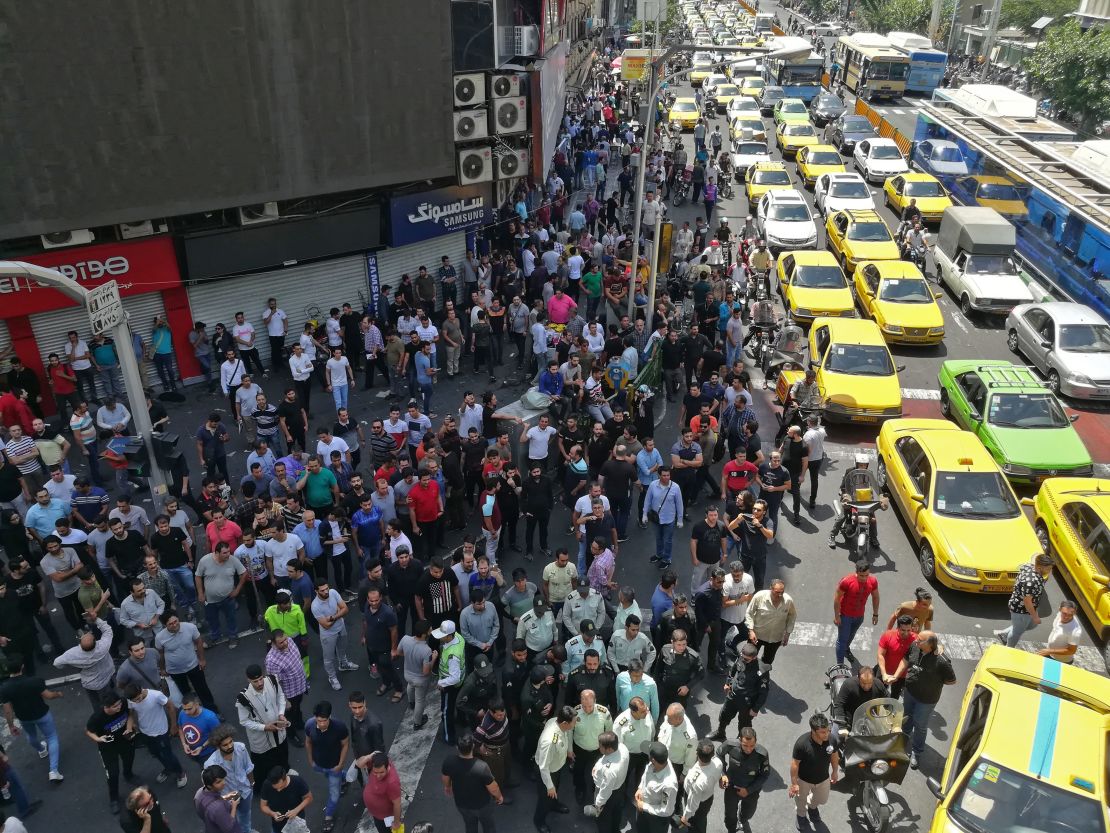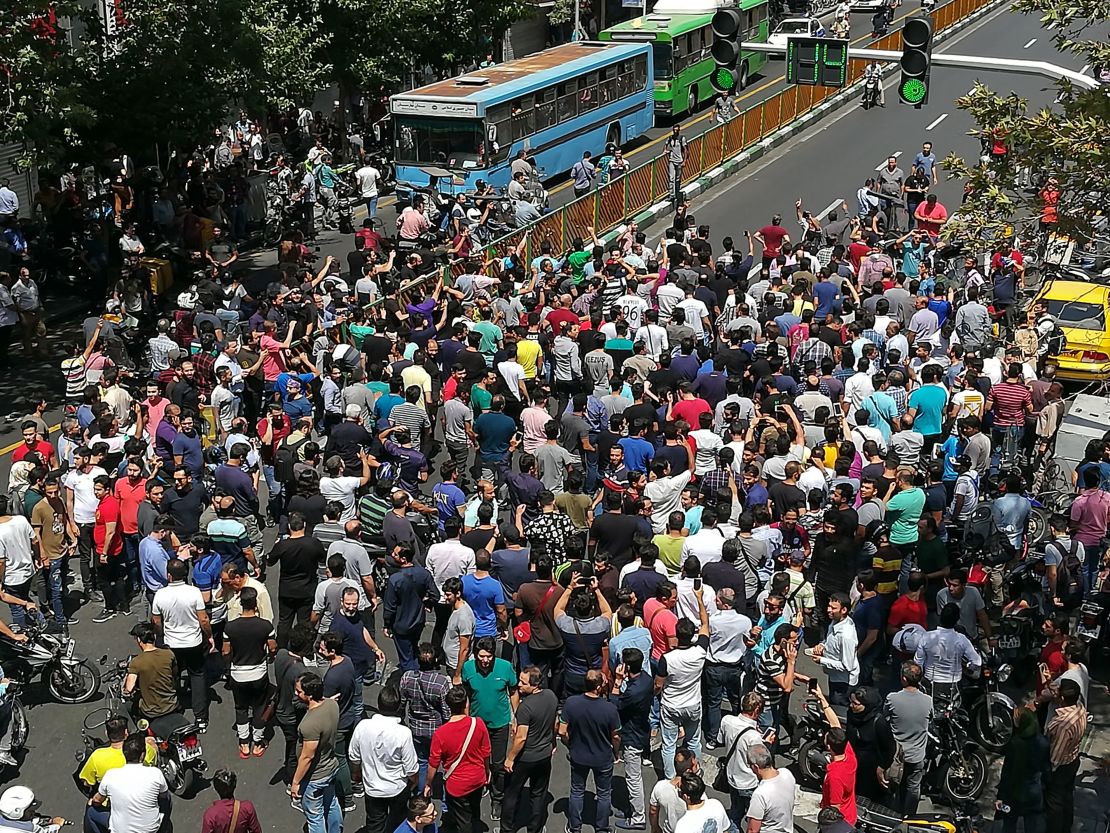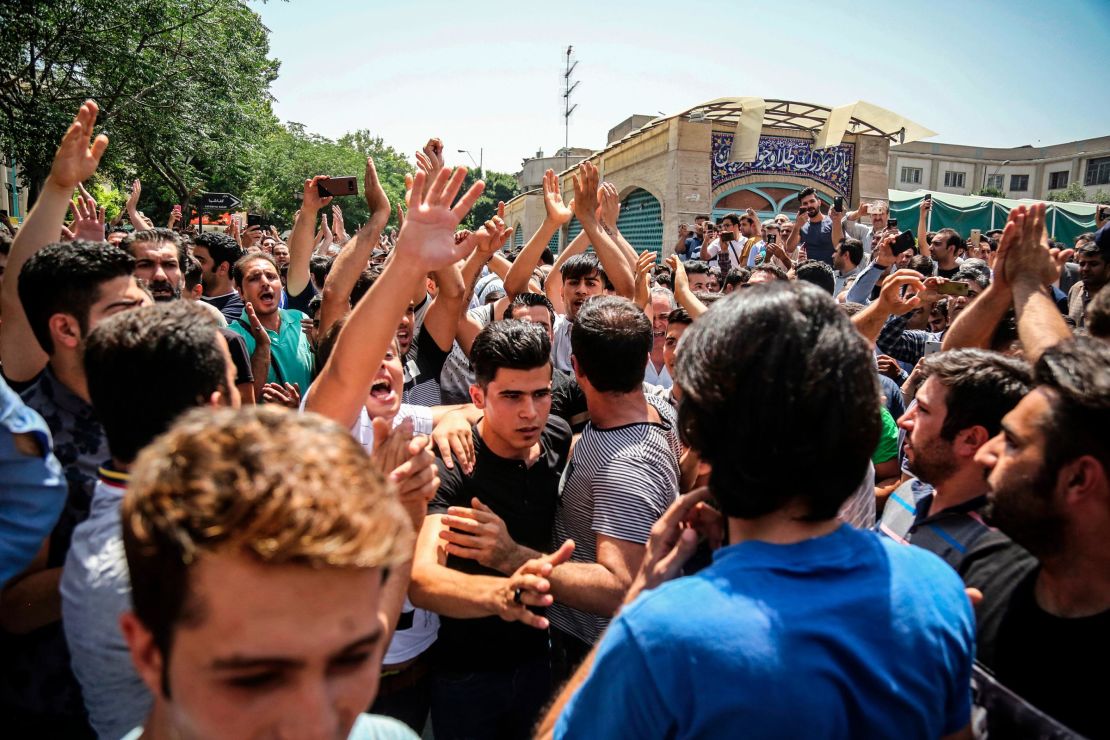A series of largely economic protests have unsettled Iran’s capital Tehran, mostly focused around traders in the Grand Bazaar and their fury over the collapse of the country’s currency in recent months.
In the past several days, social media footage appeared to show crowds of protesters reaching the gates of Iranian parliament, and other images have shown a strong police crackdown.
There was a heavy police presence in the central Tehran bazaar Wednesday after days of protests. Traders appeared confused as to who had initiated the disturbances, but several told CNN that the decline in the value of the rial had forced them to stop trading.
“There’s no incentive to do business,” said cloth merchant Fakhredin Fakhrzadegan. “Right now, when a merchant sells his goods he has to pay more to restock the same merchandise.” All of the goods in the bazaar were pegged to the dollar in its value, Fakhrzadegan explained, so a fluctuating exchange rate damaged their businesses.

“It was not clear who was behind” the protests, said china salesman Reza Radravesh, adding that merchants were not involved in the disturbances of the past few days.
“I am a shopkeeper here. Can I go out and chant slogans or set things on fire? No. I have my own troubles – debts and rent to pay – and I like to keep my shop open every day.”
Why is this happening now?
The short answer is that the rial has crashed. It took 42,000 rials to buy one US dollar at the end of last year, but it now requires 90,000. In fact it is crashing fast – rising from 87,000 as recently as Sunday. Partially in response, the government has banned the import of about 1,300 foreign goods, including household appliances and technology.
Both economic moves have directly impacted the traders of Tehran’s central bazaar, who are often stalwart supporters of the conservative government and the 1979 revolution that put them in power.
What’s behind it?
The main driver is the genuine economic grievances felt by a growing number of Iranians. There are suggestions that hardline opponents of the relatively moderate President Hassan Rouhani might – as they did at the end of last year – be fomenting some of the uproar. But the anger is real and palpable, and about a crashing currency causing the quality of life to deteriorate. Food prices and a drought, together with corruption, are also angering many Iranians.
How much of this is to do with the Iran deal?
Broadly, it’s all about the Iran deal, even though it’s not about it at all. The economy is faltering because of a lack of external investment and the restrictions put on it by international sanctions. The Iran deal, also known as the Joint Comprehensive Plan of Action or the JCPOA, was supposed to reduce those sanctions – allowing Iran back into the global economy – in return for the country curtailing its nuclear activities.

But enduring US suspicions of the deal – especially President Donald Trump’s overwhelming negativity towards it – meant that many businesses failed to invest in Iran as they feared such investment might damage their business with the US.
Now that the United States has pulled out of the deal unilaterally, the pressure has increased. European powers are trying to reduce the damage on the Iranian economy by reassuring Tehran they won’t cut and run. But the US keeps making this harder every week, only on Tuesday warning countries, including its own allies in Europe and India to stop importing Iranian oil by November or face the full wrath of US sanctions themselves.
As a result, the economic payoff of the Iran deal hasn’t really materialized and now seems even more distant given the Trump administration’s destructive approach. On top of this, Iran has been in a series of expensive and lengthy foreign military entanglements that have drained its already stretched state coffers. Some of the protest chants on social media have criticized Iran’s military presence in Syria and Yemen, where they are pursuing a goal of diminishing Saudi Arabia’s influence and increasing their own geographical reach.
Trump pulled out of the JCPOA partially because he saw it as incompatible with Iran’s military adventures, even though the deal was only hatched to limit its nuclear program alone.
Is this the outcome that the US was aiming for?
In the short-term, yes. But the US goal is – it appears – ultimately regime change, and that may not be so easy. The Trump administration seems to believe that intense economic pressure will cause one of the most heavily regulated and policed societies on earth to suddenly throw off its shackles, unseat the clerics who rule the country, and usher in a new generation of young, Western-minded moderates to power.

Benjamin Netanyahu, the Israeli Prime Minister, appeared to epitomize this train of thought, when he released a video on Twitter praising the Iranian goalkeeper Alireza Beiranvand, 25, for stopping a penalty kick by Cristiano Ronaldo during Iran’s World Cup match against Portugal. His message was that Iran is a wealth of youth, talent and enterprise, held back only by its aging theocratic rulers.
But it’s a little more complicated than the binary result of a penalty shoot-out. As the economic pressure mounts, it is Rouhani’s moderate government – not the Supreme Leader – that is taking much of the heat. There were reports that Iranian members of parliament wrote to the President demanding a cabinet reshuffle to better deal with the economic crisis.
The major risk is that economic turmoil unseats a moderate government and finds them replaced by hardliners who focus on distracting from domestic woes by fomenting foreign conflicts – precisely the reverse of the US goal.
For now the world must contend with the unsettling swing to the negative in US-Iranian relations. While Obama’s secretary of state, John Kerry, spent months getting to the point where he could privately text his Iranian counterpart Javid Zarif, his Trump-era successor Mike Pompeo spars publicly with Zarif on Twitter.
What does it say about direction the country’s heading?
Nothing good. It is unrealistic to think that Iran will suddenly throw off its regimented security structures and liberalize overnight, as the people who control the money also control the guns. So instead, expect more economic hardship, and greater fury at the West and the United States as renewed sanctions make daily life even harder.
It is possible that the Trump administration has read something fresh and remarkable in Iran’s tea leaves, and that their young, angry population just needs an extra dose of hardship to rise up. But then again, it’s also possible they are woefully simplifying one of the world’s oldest and most sophisticated societies.
Shirzad Bozorgmehr wrote and reported from Tehran. Nick Paton Walsh wrote and reported from London.
